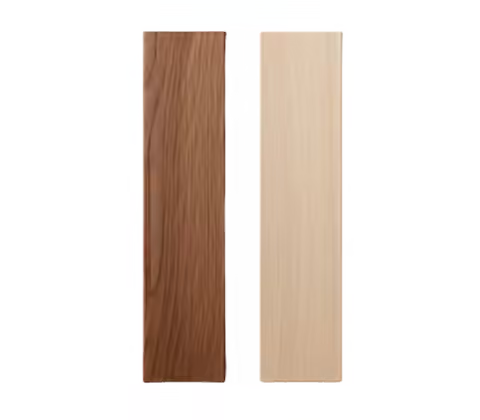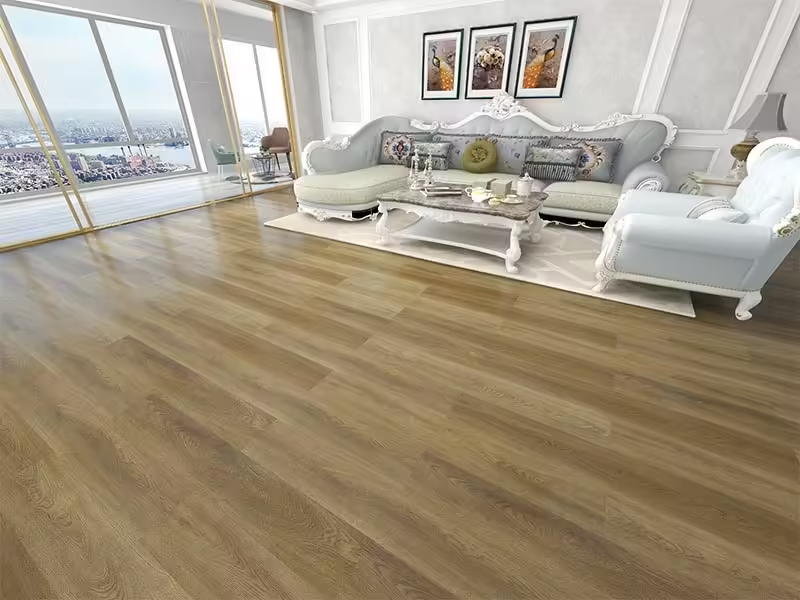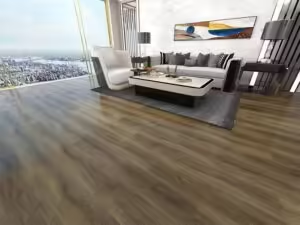Table of Contents
Introduction
When it comes to flooring options, homeowners and businesses alike are often overwhelmed by choices: hardwood, carpet, laminate, vinyl, and more. In recent years, a newer player has emerged as a game-changer in the industry: SPC flooring. But what is SPC flooring, and why is it quickly surpassing traditional vinyl as a top choice?
SPC, or Stone Plastic Composite, is a type of rigid core flooring that combines limestone powder, polyvinyl chloride (PVC), and stabilizers to create a durable, waterproof, and versatile material. Unlike traditional luxury vinyl flooring (LVP/LVT), which relies on a foam or felt backing, SPC flooring features a dense, solid core that resists dents, scratches, and temperature changes. This unique construction has made it a favorite for high-traffic areas, moisture-prone rooms, and anyone seeking a low-maintenance yet stylish flooring solution.
In this guide, we’ll dive deep into answering “what is SPC flooring” by exploring its composition, manufacturing process, and key benefits. We’ll also compare it to traditional vinyl flooring across seven critical categories—durability, water resistance, stability, comfort, eco-friendliness, cost-effectiveness, and design versatility—to show why SPC is becoming the go-to option for modern spaces. Whether you’re renovating a bathroom, upgrading a commercial office, or building a new home, understanding SPC flooring will help you make an informed decision that balances performance, aesthetics, and long-term value.
What Is SPC Flooring? A Detailed Breakdown

To truly grasp what SPC flooring is, it’s essential to start with its composition and how it’s made. Unlike traditional vinyl, which is often a single layer of PVC with a printed design, SPC flooring is a multi-layered product engineered for strength and resilience. Here’s a closer look at its structure and manufacturing process:
The Composition of SPC Flooring
SPC flooring is built around a rigid core layer made from limestone (calcium carbonate) powder mixed with PVC resin and plasticizers. This core is what gives SPC its “stone plastic composite” name and its signature hardness. On top of the core, manufacturers add:
- A print layer: A high-definition image that mimics natural materials like wood, stone, or tile.
- A wear layer: A clear, protective coating (usually polyurethane) that resists scratches, stains, and UV damage.
- A backing layer: A thin foam or cork layer that adds minor cushioning and sound absorption (though some SPC products skip this for extra rigidity).
The result is a flooring plank that’s dense, rigid, and incredibly stable—qualities that set it apart from softer vinyl options.
How SPC Flooring Is Made
The manufacturing process of SPC flooring involves several steps to ensure consistency and durability:
- Mixing the core: Limestone powder, PVC resin, and additives are blended and heated to form a molten mixture.
- Extrusion: The mixture is extruded into planks with a rigid core, using precision molds to set the shape and size.
- Printing and laminating: The print layer (with designs like oak, marble, or concrete) is applied to the core, followed by the wear layer, using high-pressure lamination.
- Cutting and finishing: Planks are cut to standard sizes (typically 4–8 inches wide and 36–72 inches long) and finished with tongue-and-groove edges for easy installation.
This process ensures that each plank is uniform in density and strength, making SPC flooring more reliable than traditional vinyl, which can vary in quality due to simpler manufacturing methods.
What Makes SPC Flooring Different from Traditional Vinyl?
Now that we’ve answered “what is SPC flooring” in terms of composition, let’s clarify how it differs from traditional vinyl flooring (LVP/LVT). The key distinctions lie in their cores:
- Traditional vinyl (LVP/LVT): Has a flexible core made of PVC and foam, which can bend or warp under heavy furniture or temperature changes.
- SPC flooring: Features a rigid, stone-based core that is 2–3 times denser than vinyl, providing superior stability and impact resistance.
This difference in core density is why SPC flooring is often referred to as “rigid core vinyl” or “stone plastic composite vinyl,” though it’s important to note that SPC is a distinct category due to its limestone-based core.
7 Reasons SPC Flooring Is Better Than Vinyl


Now that we understand what SPC flooring is, let’s explore why it outperforms traditional vinyl in seven critical areas. These advantages have made SPC a top choice for homeowners, contractors, and businesses worldwide.
1. Unmatched Durability: Resists Scratches, Dents, and Heavy Traffic
One of the most significant benefits of SPC flooring is its exceptional durability. Thanks to its dense stone-plastic core and thick wear layer (usually 20–40 mils), SPC flooring can withstand:
- Scratches from pets, furniture, and high heels.
- Dents from heavy appliances like refrigerators or washing machines.
- Heavy foot traffic in commercial spaces like offices, retail stores, or restaurants.
In contrast, traditional vinyl flooring has a softer core and thinner wear layer (often 6–12 mils), making it prone to scuffs and indentations over time. A study by the Flooring Industry Research Association (FIRA) found that SPC flooring lasted 30% longer than LVP in high-traffic tests, with minimal visible damage after 10,000 cycles of foot traffic.
2. 100% Waterproof: Ideal for Moisture-Prone Areas
Another key advantage of SPC flooring is its complete waterproofing. Because it’s made from PVC and limestone—both moisture-resistant materials—SPC flooring can handle spills, leaks, and even standing water without warping or swelling. This makes it perfect for:
- Bathrooms, kitchens, and laundry rooms.
- Basements and below-grade spaces.
- Areas with pets or children prone to accidents.
Traditional vinyl flooring is also water-resistant, but its foam backing can absorb moisture over time, leading to mold growth or delamination. SPC’s solid core eliminates this risk, giving homeowners peace of mind in wet environments.
3. Superior Stability: Resists Temperature and Humidity Changes
SPC flooring’s rigid core provides unmatched stability, even in extreme temperatures and humidity levels. Unlike traditional vinyl, which can expand or contract in hot or cold conditions, SPC planks maintain their shape and size, reducing the risk of gaps, buckling, or cupping.
This stability is especially important in regions with fluctuating climates. For example, in areas with cold winters and hot summers, SPC flooring won’t shrink in dry air or swell in humid weather, ensuring a tight, seamless fit for years. Traditional vinyl, on the other hand, may require expansion gaps and is more likely to develop visible seams over time.
4. Low Maintenance: Easy to Clean and Long-Lasting
For busy households and businesses, low maintenance is a top priority—and SPC flooring delivers. Its non-porous surface and protective wear layer make it resistant to stains, so spills like wine, juice, or oil can be wiped up with a damp cloth without leaving marks. Unlike hardwood or carpet, SPC flooring doesn’t require:
- Refinishing, sanding, or polishing.
- Special cleaners or treatments.
- Regular sealing to maintain performance.
Traditional vinyl is also low-maintenance, but its softer surface is more likely to trap dirt in scratches, requiring more frequent deep cleaning. SPC’s durability means it stays looking new with minimal effort, making it a practical choice for anyone short on time.
5. Realistic Aesthetics: Mimics Natural Materials Flawlessly
Gone are the days when vinyl flooring looked cheap or artificial. SPC flooring uses advanced printing technology to create hyper-realistic designs that mimic the texture, color, and grain of natural materials like hardwood, marble, and travertine. Some premium SPC products even feature embossed surfaces that replicate the feel of real wood or stone underfoot.
Traditional vinyl can also mimic natural materials, but its flexible core often results in a “plastic-like” appearance when installed. SPC’s rigid core allows for sharper, more detailed printing and a sturdier feel, making it nearly indistinguishable from the real thing—at a fraction of the cost.
6. Eco-Friendly: Recyclable and Low-VOC
In an era where sustainability matters, SPC flooring stands out as an eco-friendly option. Most SPC products are made from recyclable materials (PVC and limestone) and contain low levels of volatile organic compounds (VOCs), which are harmful chemicals that can off-gas into indoor air. Many SPC brands are certified by organizations like GREENGUARD or FloorScore, ensuring they meet strict indoor air quality standards.
Traditional vinyl flooring, while also recyclable, may contain higher VOC levels due to cheaper adhesives and backing materials. For environmentally conscious consumers, SPC flooring offers a greener choice without sacrificing performance.
7. Cost-Effective: Long-Term Savings Over Time
While SPC flooring may have a higher upfront cost than traditional vinyl, its durability and low maintenance make it more cost-effective in the long run. SPC flooring often comes with warranties ranging from 25 to 50 years, depending on the brand and quality, which means less frequent replacement and fewer repair costs.
To illustrate the long-term value, consider this comparison of key durability and maintenance metrics:
| Performance Metric | SPC Flooring | Traditional Vinyl |
|---|---|---|
| Warranty Length | 25–50 years | 10–20 years |
| Replacement Frequency | 1x (after 25+ years) | 2–3x (every 10–15 years) |
| Annual Maintenance Effort | Minimal (occasional sweeping/mopping) | Moderate (regular deep cleaning for scratches) |
| Scratch/Dent Resistance | High (resists heavy impacts) | Low (prone to scuffs from daily use) |
As the table shows, SPC flooring’s longer warranty, lower replacement needs, and minimal maintenance requirements reduce long-term hassle and expenses. In contrast, traditional vinyl flooring typically has shorter warranties and may require more frequent replacement or repairs due to wear and tear. The cost savings from SPC flooring can be significant, especially in commercial settings where flooring is subjected to constant use.
Conclusion
In conclusion, SPC flooring is a superior choice compared to traditional vinyl flooring. Its unique composition, durability, water resistance, stability, low maintenance, realistic aesthetics, eco-friendliness, and cost-effectiveness make it a top contender for modern flooring needs. As the flooring industry continues to evolve, SPC flooring is likely to remain a popular choice for those seeking a high-performance, stylish, and sustainable flooring solution.
When considering SPC flooring for your next project, be sure to compare different brands and products, as quality can vary. Look for certifications, warranties, and customer reviews to ensure you’re getting the best value for your investment. With its many advantages, SPC flooring is not just a trend but a lasting innovation in the world of flooring materials.
FAQ
What is the lifespan of SPC flooring compared to traditional vinyl?
SPC flooring typically has a lifespan of 25 to 50 years, depending on the brand and quality, while traditional vinyl flooring usually lasts 10 to 20 years. SPC’s longer lifespan contributes to its cost-effectiveness over time.
Is SPC flooring suitable for kitchens and bathrooms?
Yes, SPC flooring is highly suitable for kitchens and bathrooms due to its waterproof properties and resistance to moisture, humidity, and temperature changes.
Can SPC flooring be installed over existing flooring?
SPC flooring can be installed over a variety of existing subfloors, including concrete, wood, and tile, provided the subfloor is clean, flat, and dry. It’s always best to consult with a professional installer for guidance.
Are there any limitations to the design options available in SPC flooring?
SPC flooring offers a wide range of design options, from realistic wood and stone looks to modern patterns and colors. However, the variety may be more limited compared to traditional hardwood or carpet, which offer more customization options like custom stains or bespoke patterns.
How does SPC flooring perform in high-traffic commercial settings?
SPC flooring performs exceptionally well in high-traffic commercial settings due to its durability, stability, and low maintenance requirements. Its resistance to scratches, dents, and fading ensures it can withstand constant use without significant wear.
Is SPC flooring recyclable, and how should it be disposed of at the end of its life?
Yes, SPC flooring is recyclable, and it should be disposed of through local recycling programs or by contacting the manufacturer for recycling options. Many SPC flooring brands have take-back programs or partnerships with recycling facilities to ensure environmentally responsible disposal.
Let’s Keep in Touch! 🌟

Thanks for reading—I’m glad you joined me on this journey!
If you found this content valuable, insightful, or thought-provoking, I’d love to hear your thoughts.
📘 Follow me on Facebook for exclusive tips, behind-the-scenes insights, and community discussions.
👉 Click here to connect
Feel free to share your feedback or questions in the comments or on social media—I’m always here to chat.
Let’s keep exploring, learning, and growing—together! 🚀😊
